
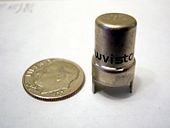
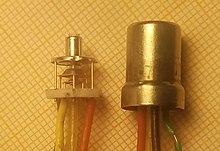
The nuvistor is a type of vacuum tube announced by RCA in 1959. Nuvistors were made to compete with the then-new bipolar junction transistors, and were much smaller than conventional tubes of the day, almost approaching the compactness of early discrete transistor casings. Due to their small size, there was no space to include a vacuum fitting to evacuate the tube; instead, nuvistors were assembled and processed in a vacuum chamber with simple robotic devices. The tube is made entirely of metal with a ceramic base. Triodes and a few tetrodes were made; Nuvistor tetrodes were taller than their triode counterparts.
Nuvistors are among the highest performing small signal receiving tubes.[citation needed] They feature excellent VHF and UHF performance plus low noise figures, and were widely used throughout the 1960s in television sets (beginning with RCA's "New Vista" line of color sets in 1961 with the CTC-11 chassis), radio and high-fidelity equipment primarily in RF sections, and oscilloscopes. RCA discontinued their use in television tuners for its product line in late 1971.
Other nuvistor applications included the Ampex MR-70, a studio tape recorder whose entire electronics section was based on nuvistors, as well as studio-grade microphones from that era, such as the AKG/Norelco C12a, which employed the 7586. It was also later found that, with minor circuit modification, the nuvistor made a sufficient replacement for the obsolete Telefunken VF14 tube, used in the Neumann U47 studio microphone.[1] Tektronix also used nuvistors in several of its high end oscilloscopes of the 1960s,[2] before replacing them later with JFET transistors. Nuvistors were used in the Ranger space program and in the MiG-25 fighter jet, presumably to harden the fighter's avionics against radiation. (See radiation hardening.) This was discovered following the Defection of Viktor Belenko.
| Parts of a small Nuvistor triode | Pictures |
|---|---|
| 7586 Nuvistor triode. Two lugs (one large and one small) adjacent to pins 2 and 4 locate the valve in its socket, which is shown alongside. | 
|
| 7586 Nuvistor triode. Twelve pins protrude through the ceramic base, some of which are long and form the connections to the heater, cathode, grid and anode electrodes. These short pins support the internal structure, along with the long ones. | 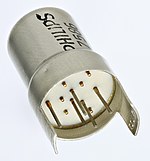
|
| The metal envelope has been removed. View of the tube base, anode or plate and support pins. | 
|
| View of the tube base, anode or plate and support pins. Note that there are no mica spacers used to support and separate internal structures, as in normal valves. | 
|
| The anode has been removed. The vertically oriented, mesh wire electrode is the control grid. | 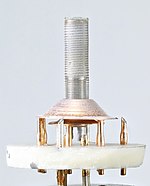
|
| The control grid has been removed. The vertically oriented electrode is the cathode. The indirectly heated cathode surrounds the heater. The electron emitting portion of the cathode is the white-colored oxide coating, typically barium oxide or strontium oxide. | 
|
| The cathode has been removed. The heater is tungsten wire coated with a refractory dielectric material of high thermal conductivity. | 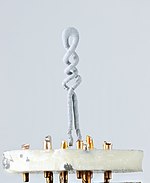
|